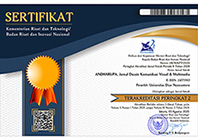Perancangan Buku Cerita Bergambar Pengenalan Esensi Perjuangan R.A Kartini kepada Generasi Muda
DOI:
https://doi.org/10.33633/andharupa.v9i4.9204Abstract
AbstrakR.A Kartini adalah pejuang emansipasi wanita yang konsisten memperjuangkan hak kaum wanita supaya setara dengan kaum pria. Beliau membuka sekolah wanita pertama serta berjejaring korespondensi dengan koleganya di Belanda sampai akhir hayat. Namun kini pemahaman generasi muda tentang perjuangan RA Kartini menurun. Perjuangan RA Kartini hanya dikenang dengan melakukan selebrasi dan sebatas memakai kebaya dan perlombaan. Selain itu belum adanya buku cerita bergambar versi cetak dan versi digital yang bisa diakses secara luas dan mudah tentang perjuangan RA Kartini. Menilik permasalahan tersebut, tujuan penelitian ini adalah mengenalkan esensi perjuangan R.A Kartini kepada generasi muda dalam bentuk buku cerita bergambar versi cetak dan digital. Metode penelitian deskriptif kualitatif dipilih melalui pendekatan analisis framing. Target audience penelitian ini adalah generasi muda socio-economic status B dengan segmentasi psikografis gaya hidup teknologi-savvy. Penelitian terdahulu menjadi landasan pengembangan penelitian ini, yang mana perbedaannya terletak pada konten yang disajikan. Penelitian terdahulu fokus pada peninggalan RA Kartini, sedangkan penelitian saat ini fokus pada esensi cerita perjuangannya. Kata Kunci: buku cerita bergambar, esensi perjuangan, R.A Kartini AbstractR.A Kartini was a fighter for women's emancipation / who consistently fought for women's rights to be equal to men. He opened the first women's school and maintained correspondence with colleagues in the Netherlands until the end of his life. However, now the younger generation's understanding of RA Kartini's struggle is declining. RA Kartini's struggle is only remembered by celebrating and limited to wearing a kebaya and competing. Apart from that, there are no printed or digital versions of illustrated story books that can be widely and easily accessed about RA Kartini's struggle. Considering these problems, the aim of this research is to introduce the essence of R.A Kartini's struggle to the younger generation in the form of printed and digital versions of illustrated story books. The qualitative descriptive research method was chosen through a framing analysis approach. The target audience for this research is the young generation of socio-economic status B with a psychographic segmentation of a technology-savvy lifestyle. Previous research became the basis for developing this research, the difference lies in the content presented. Previous research focused on the legacy of RA Kartini, while the research carried out focused on the essence of the story of her struggle. Keywords: essence of struggle, picture storybook, R.A KartiniReferences
Anggito, A. dan Setiawan, J. 2018. Metode Penelitian Kualitatif. Edisi pertama. Sukabumi: CV Jejak.
Arifin, Syamsul, and Adi Kusrianto. 2009. Sukses Menulis Buku Ajar dan Rerefensi. Edisi pertama. Jakarta: Grasindo.
Asfandiyar, Y. A. 2007. Cara Pintar Mendongeng. Edisi kedua. Jakarta: Mizan.
Bunanta, M. 2017. Budaya Mendongeng yang Tergerus Zaman. Diakses dari: https://www.medcom.id/rona/keluarga/VNxJpJqk-budaya-mendongeng-yang-tergerus-zaman [diakses pada 13 Desember 2023].
Entman, R. M. 2007. Framing Bias: Media in the Distribution of Power. Journal of Communication, 57 (1), pp.163-173.
Faizah, U. 2009. Keefektifan Cerita Bergambar Untuk Pendidikan Nilai Dan Keterampilan Berbahasa Dalam Pembelajaran bahasa Indonesia. Cakrawala Pendidikan.
Ideo, W. dan Maya, N. 2009. Seri Pahlawan Nasional.: R. A. Kartini. Jakarta: Bee Media Indonesia.
Kementerian Keuangan Republik Indonesia. 2021. Kartini dan Kesetaraan Gender: No One Left Behind. URL: https://www.djkn.kemenkeu.go.id/kanwil-jabar/baca-artikel/13859/Kartini-dan-Kesetaraan-Gender-No-One-Left-Behind.html
[Diakses pada 20 Februari 2023].
Kusrianto. 2009. Pengantar Desain Komunikasi Visual. Yogyakarta: CV ANDI OFFSET.
Lawson, B. 2005. How Designers Think: The Design Process Demystified. Architectural Press.
Musafiroh, T. 2008. Perkembangan Kecerdasan Majemuk. Jakarta: Grasindo.
Nurgiyantoro, B. 2005. Satra Anak Pengantar Pemahaman Dunia Anak. Yogyakarta: Gadjah Mada University Press.
Prayogo, Y. 2020. Inilah 8 Buku yang Berkisah tentang Kartini, Pramoedya pun Menulis. URL: https://www.kalderanews.com/2020/04/inilah-8-buku-yang-berkisah-tentang-kartini-pramoedya-pun-menulis/ [Diakses pada 20 Februari 2023].
Priyanto, H. 2021. Nilai-nilai Utama Keteladanan R.A. Kartini. URL: https://suarabaru.id/2021/09/17/nilai-nilai-utama-keteladanan-r-a-kartini-2
[Diakses pada 20 Februari 2023].
Purwani, R. 2020. Pengembangan Buku Cerita Bergambar Berbasis Karakter untuk Pembelajaran Membaca Siswa SD Kelas IV. Jurnal PBSI, 8 (2), pp.180-194.
Pusindo, Tim Media. 2007. Pahlawan Indonesia. Depok: Puspa Swara Group.
Putra, A., Damayanti, P. S. dan Srirahmawati, I. 2022. Bimbingan dan Konseling Solusi Pendidikan Karakter Anak Sekolah Dasar. Solok: CV Mitra Cendikia Media.
Prasetyawati, A. 2020. Digital Storyteling Kog Bisa?: Mengubah Keberlimpahan Informasi Menjadi Media Edukasi. Jurnal IPTEK-KOM, 22 (2), pp: 199-212
Saputro, G. E., Haryadi, T., & Wahyuningsih, S. E. 2022. Design of Virtual Gallery Museum R.A Kartini Jepara Through the Mobile Learning Approach. The 4th Vocational Education International Conference. https://www.atlantis-press.com/proceedings/veic-22/125978686.
Saputro, G. E. & Haryadi, T. 2018. Edukasi Kampanye Anti Hoax Melalui Komik Strip. Jurnal Demandia, 15 (2), pp: 94-111
Tabrani, P. 2005. Bahasa Rupa. Bandung: Kelir.
Wardiah, D. 2017. Peran Storytelling dalam Meningkatkan Kemampuan Menulis, Minat Membaca dan Kecerdasan Emosional Siswa. Jurnal Wahana Didaktika, 15 (2), pp: 42-56.
Yustika, G. 2022. Mengenal Perjuangan Kartini Melalui Buku Habis Gelap Terbitlah Terang. URL: https://www.orami.co.id/magazine/habis-gelap-terbitlah-terang [Diakses pada 20 Februari 2023].
Zuana, Muhammad Mujtaba Mitra. 2018. Digital Storytelling: An Attractive Media to Teach Narrative Text in Speaking Class.” ALSUNA : Journal of Arabic and English Language 1 (1), pp: 26–39
Downloads
Published
Issue
Section
License
Authors who publish with this journal agree to the following terms:
- Authors retain copyright and grant the journal right of first publication with the work simultaneously licensed under a Creative Commons Attribution License that allows others to share the work with an acknowledgment of the work's authorship and initial publication in this journal.
- Authors are able to enter into separate, additional contractual arrangements for the non-exclusive distribution of the journal's published version of the work (e.g., post it to an institutional repository or publish it in a book), with an acknowledgment of its initial publication in this journal.
- Authors are permitted and encouraged to post their work online (e.g., in institutional repositories or on their website) prior to and during the submission process, as it can lead to productive exchanges, as well as earlier and greater citation of published work (See The Effect of Open Access).















